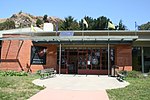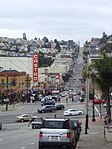Eureka Valley station
Abandoned rapid transit stationsFormer Muni Metro stationsRailway stations closed in 1972Railway stations in the United States opened in 1918Railway stations located underground in California

Eureka Valley station is an abandoned underground streetcar station in San Francisco, California. It was located inside the Twin Peaks Tunnel, very close to its eastern end in the Eureka Valley neighborhood. The station opened in 1918, and was closed in 1972 during the construction of the Market Street subway.
Excerpt from the Wikipedia article Eureka Valley station (License: CC BY-SA 3.0, Authors, Images).Eureka Valley station
Market Street, San Francisco
Geographical coordinates (GPS) Address Nearby Places Show on map
Geographical coordinates (GPS)
| Latitude | Longitude |
|---|---|
| N 37.76175 ° | E -122.43822222222 ° |
Address
Market Street 2650;2652
94114 San Francisco
California, United States
Open on Google Maps








